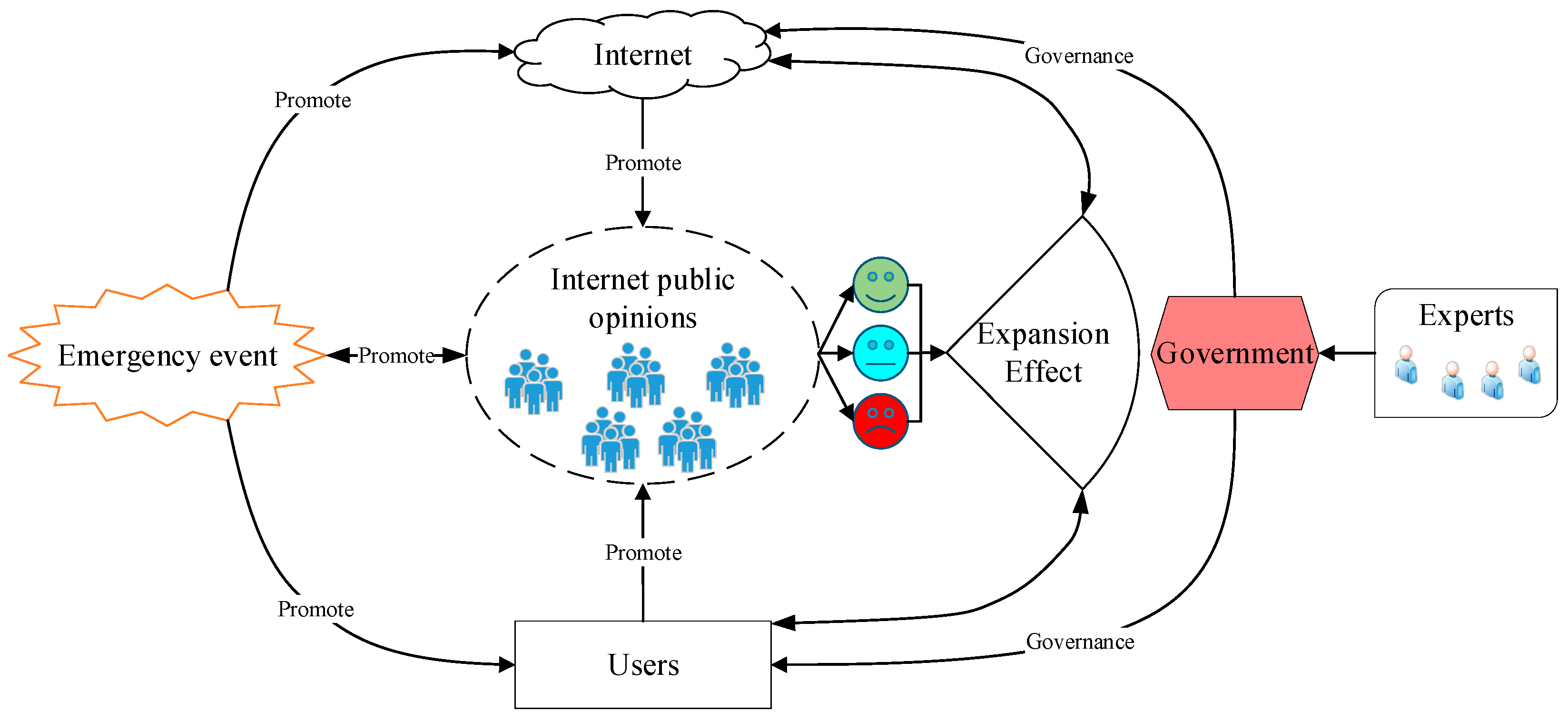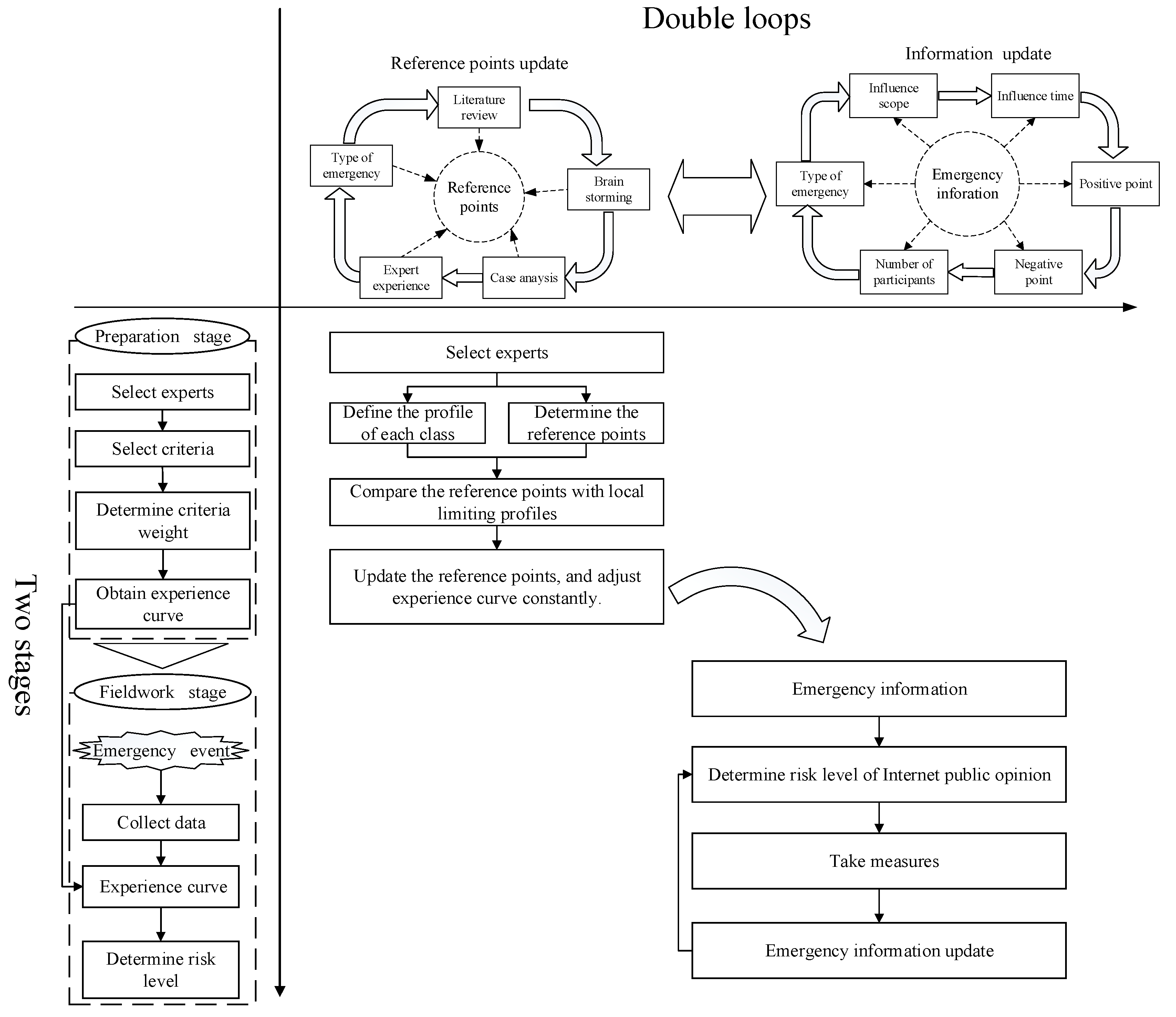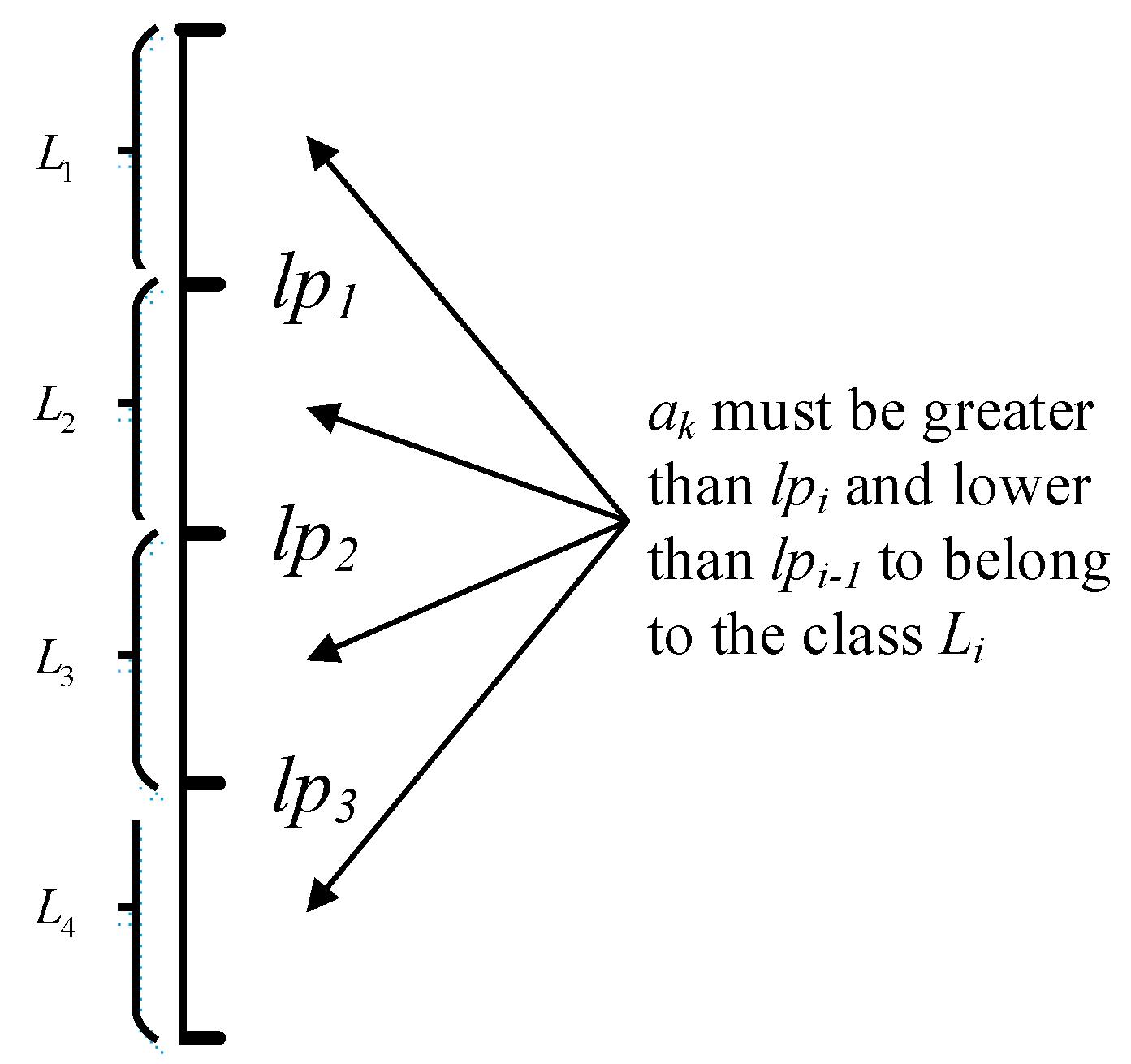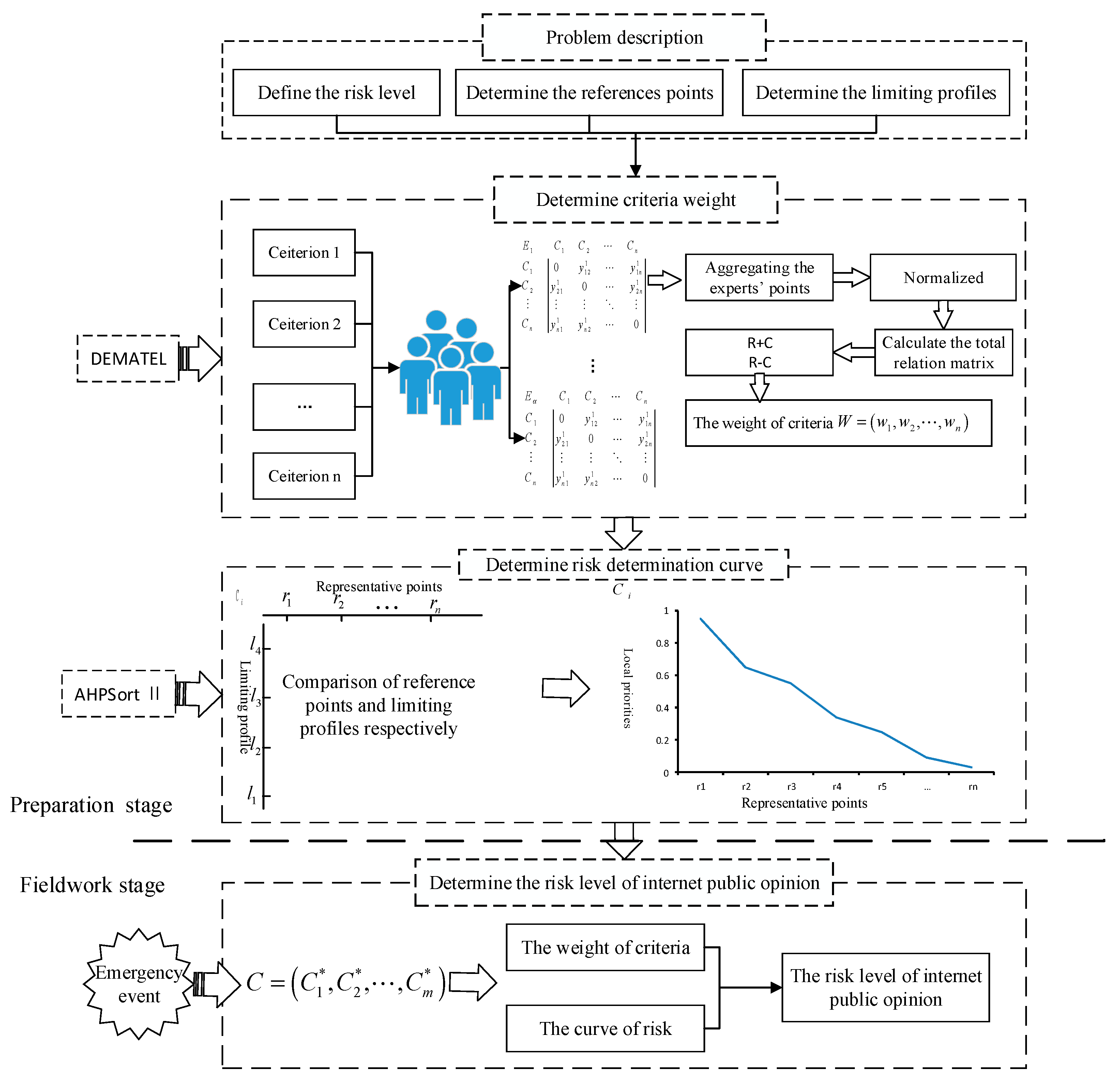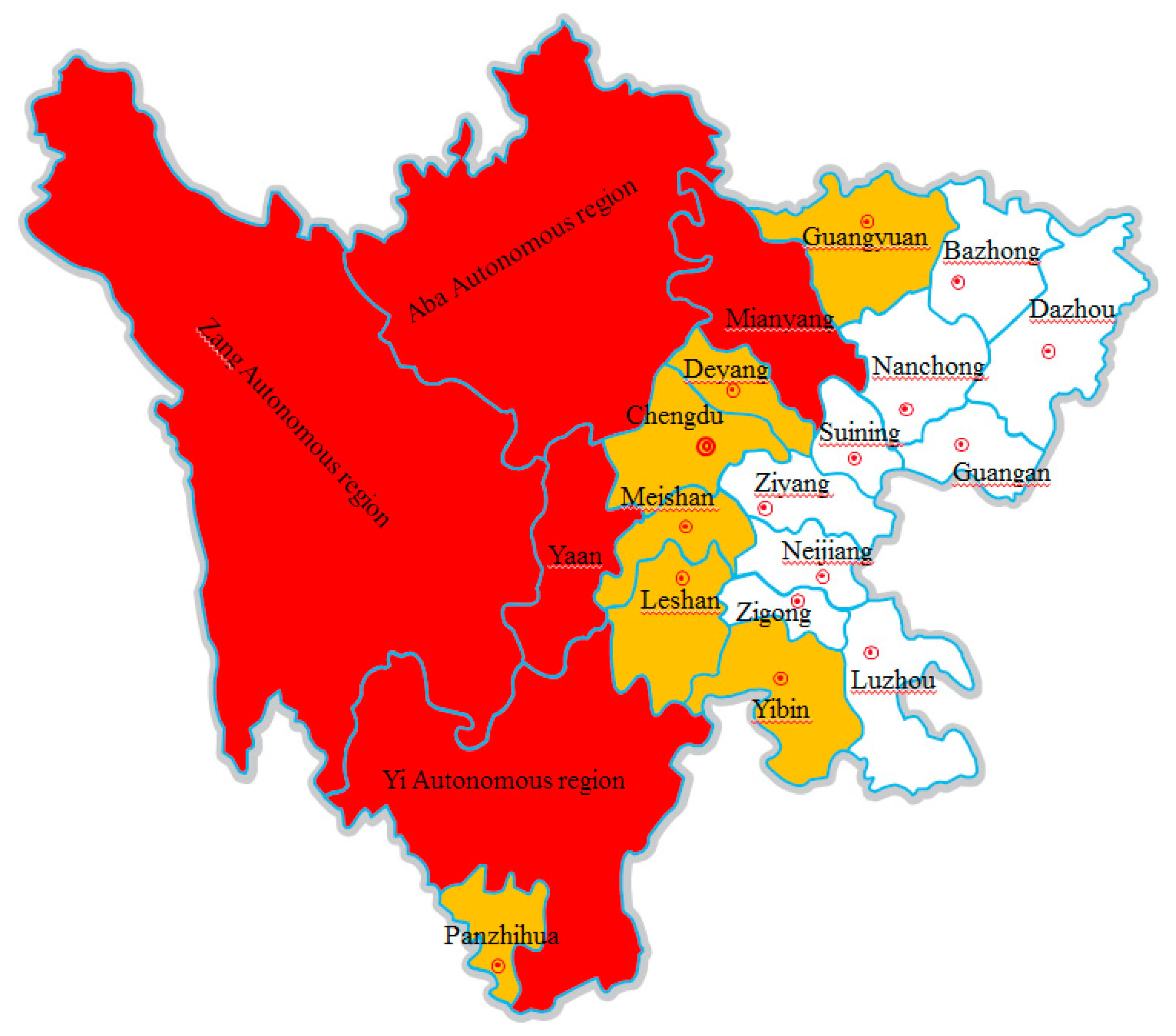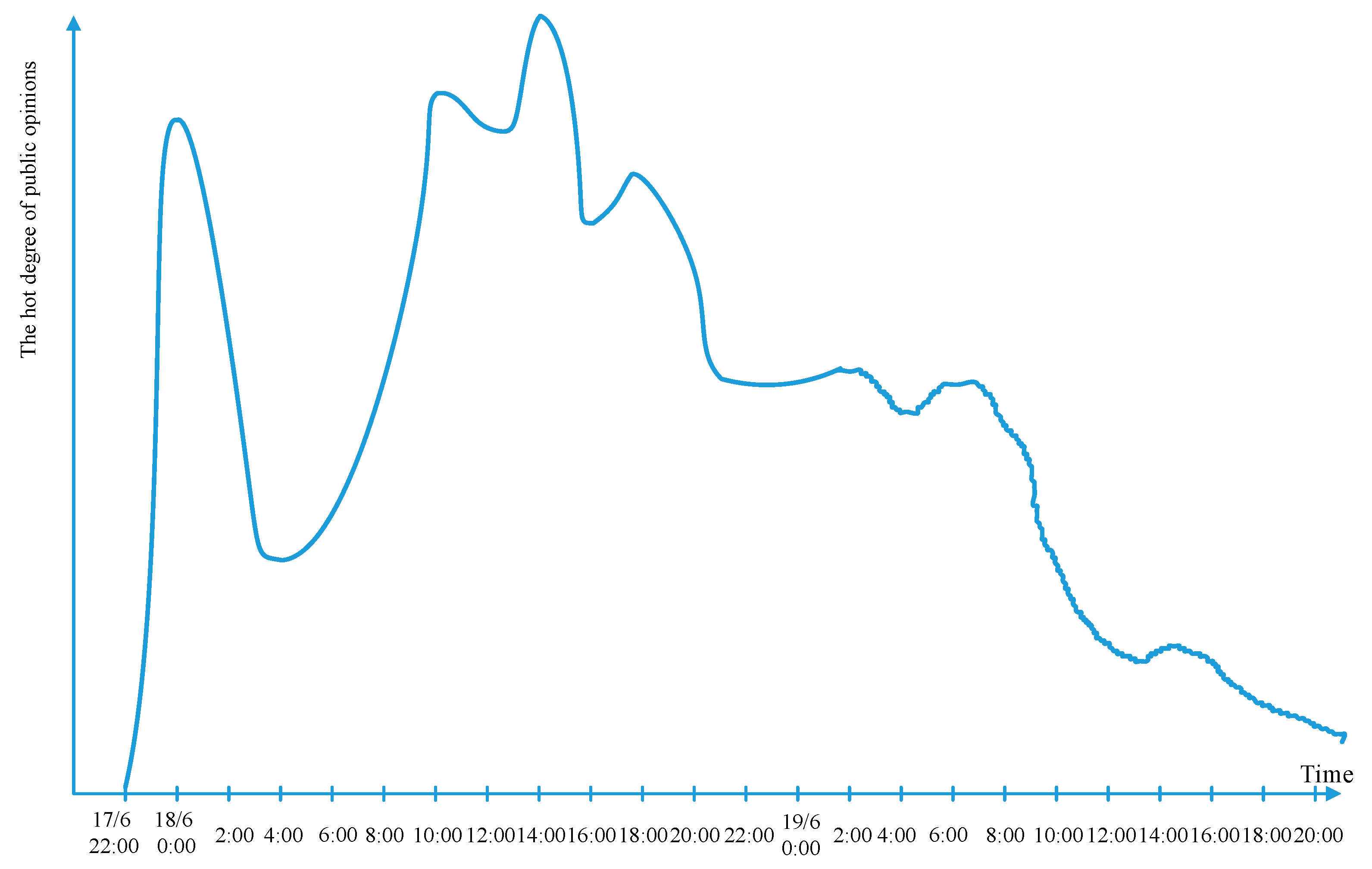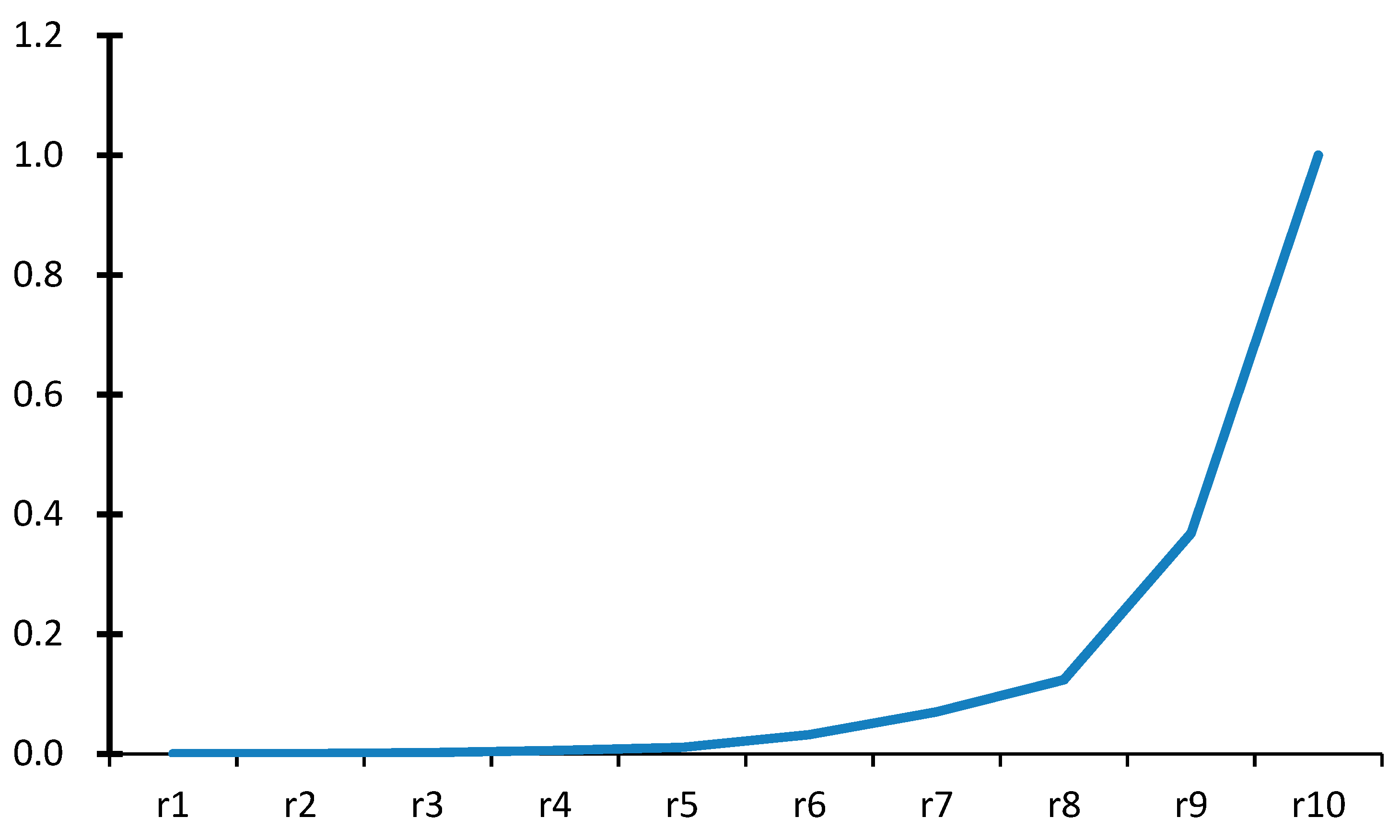1. Introduction
With the rapid development of the internet, online social platforms have become increasingly important channels for people to post, access and exchange information. Some examples of such social network websites and applications include Tencent QQ, WeChat, Micro-blog, Facebook, and Twitter, which connect users in different geographical locations and time zones. Research has demonstrated that public opinion propagation has taken place on these sites. More and more people tend to express their standpoints of an emergency event on the internet platform, which could easily lead to public opinions [
1]. Moreover, people are increasingly relying on internet public opinions to make decisions [
2]. Different from traditional media public opinions, internet public opinions have the characteristics of high liquidity, accessibility and concealment [
3]. Gushes of internet public opinions may trigger unexpected incidents that significantly affect social security and stability, especially in the public area [
4]. Meanwhile, compared to traditional media views, internet media users may hold more radical views due to the breeding of extreme views through communication among like-minded people [
5]. To ensure public safety, it is useful to study the governance of internet public opinion and classify its risk levels.
A number of recent reviews have demonstrated the growing academic interests in internet public opinion. It has been shown that online social networks have become the main communication platform for public emergencies, which has also made public opinion’s influence spread more widely [
6]. Soffer and Gordoni [
1] showed that people are willing to express opinions in the public platform. Kim et al. [
7] applied social internet analysis (SNA) to examine the mechanism of opinion diffusion. Based on the super-internet theory, Ma and Liu [
8] established a super-work model which included social, environmental and psychological-viewpoint sub-internets. From the perspective of public opinion propagation, Huang et al. [
6] used SNA and emotion mining analysis to study the interaction and evolution mechanism between the subject and the environment. Social media has been shown to be more likely to facilitate the emergence of internet public opinions [
9], and internet usage has turned out to be the most effective means of civic engagement for emergency events [
10]. Hampton [
11] explored the relationship between the use of social media, attitudinal strength, perceived opinion agreement with social ties, and willingness to discuss a political issue in different online and offline contexts. Cao and Fu [
12] proposed three types of internet public opinion problems based on uncertainty theory and the propagation process, and Huo and Ma [
13] found that there exists a golden time for government intervention.
Some studies have focused on using super-internets for prediction. Liu et al. [
14] proposed a super-internet model for public opinion prediction and governance. Another prediction model was built based on the grey system theory and the fuzzy neural internet [
15]. Fidino et al. [
16] assessed online public opinions toward wildlife by collecting comments made on YouTube videos. Chen et al. [
17] proposed a model that could accurately predict public opinion duration and identified its influencing factors. Other examples of internet public opinions can be found regarding autonomous vehicles [
18], automated driving [
19], and sex education [
20].
The government controls internet public opinions by enhancing its claims to legitimacy, circumscribing dissent, identifying malfeasance in its agents and using internet public opinions to adapt policies and direct propaganda efforts [
21]. Lian et al. [
22] described the topology of internet public opinions, and their description of the degree distribution of the internet public opinion was better than the traditional degree. Xu et al. [
23,
24,
25,
26] conducted a systematic study on rumors, and Zhang et al. [
27] and Zhang and Xu [
28] proposed a rumor-spreading model in the fuzzy set context. Liu et al. [
29] presented a novel rumor propagation SEIR (Susceptible Exposed Infected Removed) model and identified the rumor spreading threshold.
Crisis management [
30] and the SARF (social amplification of risk framework) theory [
31] are two research streams about risk management. There are a great deal of uncertainties of emergencies, like geographical and spatiotemporal uncertainty [
30], which increase the difficulty of crisis management. Gutteling and De Vries [
32] paid attention to risk information seeking of emergencies, and they introduced a risk information seeking model. Kasperson et al. [
33] proposed the phenomenon that the interpretation and response to information flow form the social amplification of risk. In other words, internet public opinions will be amplified with rumors and even cover the truth of the emergencies. This paper aims to study internet public opinion risk intelligent grading based on the crisis management and the SARF theory.
The aforementioned existing research on internet public opinion has mainly been aimed at identifying the influencing factors of public opinion, the prediction of public opinion development and the research of internet public opinion structure. However, research is scarce on public opinion governance and public opinion risk classification, and few have applied a multiple criteria decision making method [
34,
35]. This research aims to analyze the formation mechanism of internet public opinions and construct an intelligent grading model of public opinion risk levels, a model which can correctly estimate the impact and consequences of rumors. This research provides a new approach to grade the risk level of internet public opinion, and it gives some suggestions on how to control and take measures for internet public opinion risk.
The remainder of this research is structured as follows. The conceptual model of internet public opinion governance is proposed in
Section 2. The Analytic Hierarchy Process Sort II (AHPSort II)-Decision-Making Trial and Evaluation Laboratory (DEMATEL) approach is presented in
Section 3 to grade internet public opinion risk level.
Section 4 provides a case study which applies the AHPSort II-DEMATEL in internet public opinion grading, and, from there, managerial suggestions are provided. Finally, conclusions and future works are summarized in
Section 5.
2. Conceptual Model of Internet Public Opinion Governance
The internet is the major platform for the public to access information under emergent events. Public opinion governance plays an important role in governmental credibility. In the following, we introduce a conceptual model to capture the formation process of internet public opinions.
2.1. Importance of Internet Public Opinions Risk Management to Sustainability of Society
The management of internet public opinions plays an important role in maintaining social stability and harmony. The benefit and the need of internet public opinion risk management can be summarized as the following.
- (1).
Internet public opinion risk management is beneficial for the response to emergency events. The evolution process of internet public opinions reflects the process of emergencies. The internet has become an important channel for public emergencies, and it also makes public opinions spread widely and uncontrollably [
16]. Meanwhile, internet public opinion has a great impact on the solutions of public emergency events, judicial decisions, and even government decisions.
- (2).
Internet public opinion risk management is conducive to the sustainable development of society. The internet is a platform on which people express their demands and views. Due to the openness, timeliness and participation of the internet platform and the distortion of information, the risk of emergencies is expanded in the internet public platform, even with rumors. It is easy to cause social mood fluctuations, even social panic, and this affects social stability. Meanwhile, positive public opinion promotes the sustainable and harmonious development of society [
36]. Therefore, it is particularly necessary to intervene, control, restrain and guide internet public opinion.
- (3).
Internet public opinion risk management effectively weakens the negative impact of emergencies. Guidance by governments determines the development of internet public opinions. It is an effective measure to control the leader of public opinions, like a well-known blogger, who greatly affects and guides the public opinion.
2.2. Process of Internet Public Opinions Formation
The formation process of an internet public opinion is shown in
Figure 1. The internet contains a collection of cognitions, attitudes, emotions and behavioral tendencies of people who spread opinions regarding emergency events. Studying these opinions’ formation processes, therefore, is of great significance.
The internet promotes quick information transmission when emergencies occur. An emergency event promotes internet public opinions, and the internet expands public opinions. However, users cannot obtain full information about emergency events because of information asymmetry. Meanwhile, users carry different educational backgrounds, information sources, and values; thus, their attitudes to emergency events are different. Negative public opinions, neutral public opinions and positive public opinions can all be produced at the occurrence of an emergency event. These opinions are then disseminated by the internet, making global internet public opinions. Meanwhile mainstream views influence global internet public opinions and play an important role in government decision making. The attitude and decision of governments to emergencies affect their credibility. A failure of an official response, improper media response or improper media reports can bring negative effects to public ecology and social harmony. Meanwhile, the internet speeds up the spread of mainstream ideas. Therefore, it is important to classify the risk levels of emergency internet public opinions in time, a classification which is also a good way to promote the governance of internet.
2.3. Conceptual Model of Internet Public Opinion Risk Grading
The conceptual model of internet public opinion risk grading is shown in
Figure 2, and this model includes two-stages and double loops. The two-stages are the preparation stage and the field work stage. The double loops contain reference point update and information update.
In the preparation stage, the main target is to obtain the experience curve of every criterion. A group of experts are selected first, and then the criteria are selected by brainstorming and text analysis approaches. The weights of criteria are further determined by the experts. The public opinion about an emergency event is monitored in real time, which provides evaluation information for each criterion. In the fieldwork stage, the goal is to grade the risk of internet public opinion. We can determine the risk levels of internet public opinions based on the information of the emergency event and the experience curve of each criterion. Note that the risk levels of internet public opinions toward an emergency event can be evaluated in real time.
As shown in
Figure 2, the updates of reference points and emergency information are interrelated. In the reference point update loop, reference points can be selected according to text analysis, expert discussions, historical case studies, brainstorming or the types of current emergencies. The emergency internet public opinion risk level grading system can deal with uncertainty and complexity. With advances of internet technology, the reference point and profile point can be adjusted belong to the emergency event.
The grading of internet public opinion risk levels is critical in developing early warnings of internet public opinion risk. The steps are as follows.
3. Internet Public Opinion Intelligent Grading Based on AHPSort II-DEMATEL
The Decision-Making Trial and Evaluation Laboratory (DEMATEL) is built on the basis of graph theory and is best suited for analyzing complex structural models [
37,
38]. It can effectively assess total relations and construct a map between system components (criterion). AHPSort II [
39] is a new multi-criteria sorting method for a high number of alternatives which extends from the Analytic Hierarchy Process (AHP) method [
40]. It is a good technique to reduce the complexity of calculation. According to the conceptual model of internet public opinion governance, we propose an intelligent grading approach whose steps are as follows.
3.1. Definition of Internet Public Opinion Grading Problem
Step 1. Define the risk levels of internet public opinions.
The risk levels are defined as very high risk (
), high risk (
), low risk (
), and very low risk (
), as shown in
Figure 3, and the description of the risk levels is shown in
Table 1.
is the set of limiting profiles of criterion
, which can be defined by experts based on the risk levels. If the emergency internet public opinion risk value
is assigned to the level
, then
Let be the set of experts, and the weights of experts are given as . are the sets of criteria with respect to the internet public opinion risk grading problem.
Step 2. Determine references points for each criterion.
AHPSort II requires experts to determine the reference points in advance; this is a vital step of the method. Different reference points can have a great influence on drawing the judgment curve. There are two ways to define the reference points for each criterion .
- (1).
Based on the similarity case of the emergency event, select the reference points for criterion
, as shown in
Figure 4. The number of reference points
N can be given by the top
of similarity cases, or
(
the number of the case).
- (2).
Determine the maximum and minimum values of each criterion, and the number of reference points
N can be defined by experts. The reference points can be determined by equal distance (see
Figure 5).
3.2. Definition of Internet Public Opinion Grading Problem
Step 3. The expert pairwise compares the criteria by linguistic term and transform the linguistic terms to their corresponding triangular fuzzy sets (TFS) based on
Table 2.
Step 4. Aggregate the experts’ points by Equation (1) and obtain the comprehensive evaluation matrix
, when
,
.
Step 5. Calculate the total relation matrix. Due to the comprehensive evaluation matrix
, the total relation matrix can be derived by Equation (2), which contains direct and indirect relations between the factors.
Proof. , where and . Therefore . □
Step 6. Construct the DEMATEL map. Based on the total relation matrix, the sum of each row (
) and column
(
) are calculated based on Equations (4) and (5). Then,
and
can be obtained by Equations (6) and (7).
indicates the impact of i-th influential factor and its degree of being impacted.
is defined as the importance of factors and classifies the
i-th influential factor into the cause or effect category in the researching system.
Step 7. Obtain the weights of criteria by the value of
R + C.
3.3. Judgment Curve of Internet Public Opinion Grading
Step 8. Pairwise compare the limiting profiles with the reference points for each criterion
. In this step, we can reduce the number of pairwise comparisons using the method by Miccoli and Ishizaka [
33]. Assume that the number of reference points is
N and the references points are divided to
clusters. The priorities are calculated for the
clusters, as shown in
Figure 6.
The priorities are calculated for the
k clusters. Local priorities of the latter clusters are linked to the previous one by multiplying them by the ratio of the scores of joining points. The clusters are shown in
Figure 7.
5. Conclusions
The internet is an open platform with high liquidity, accessibility and concealment for the public to express their respective views on certain events. Therefore, it is vital to form an effective response and management system to classify and grade risk levels. In this paper, the mechanism of internet public opinion formation was proposed, and it was found that the internet plays a vital role in promoting the dissemination of public opinions. The attitude and decision of the government have important influences on the development of internet public opinion. Additionally, a conceptual model of internet public opinion, two stages and double loops, was built. Next the AHPSort II-DEMATEL approach was proposed to grade the risk levels of internet public opinions. Finally, an application of the proposed method to grade the risk levels of internet public opinions was provided to demonstrate the effectiveness of the proposed method. This research of internet public opinion risk management can greatly promote stability and harmony, both of which are of great significance to ensure the sustainable development of society.
However, there are also some limitations of this research work: (1) The decision-making situation in a variety of language environments was not considered. (2) The uncertainty of expert weight was not taken into account.
For future research, we aim to first reduce the impact of the approximation—we will pay more attention to the proportional relationship between the number of reference points and data scales to guarantee highest possible precision, along with fewer comparisons in AHPSort II. Then, in order to expand methods for grading the risk level of internet public opinion, we will expand the DEMATEL-AHPSort II to different linguistic environments. These aspect will all be considered in future research.
